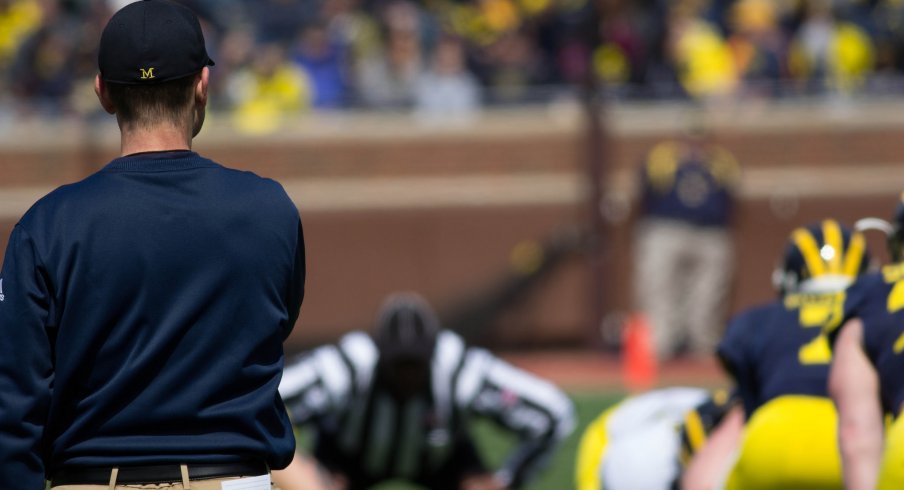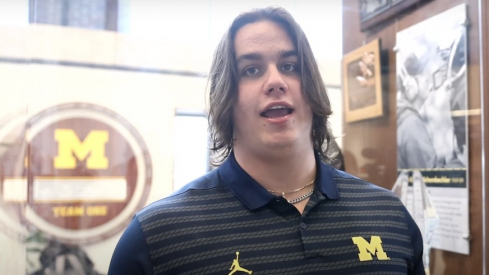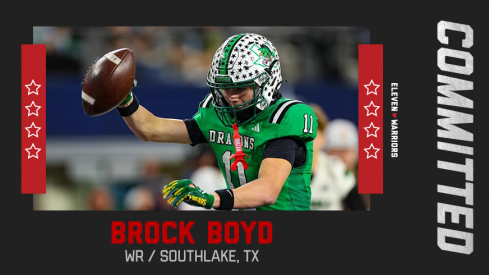Jim Harbaugh has certainly made his presence known since returning to Ann Arbor five months ago.
The one-time disciple of coaching legend Bo Schembechler has done everything in his power to raise the profile of the stagnating program, not only looking to catch up to the success of their rivals in Columbus, but to their one-time 'little brothers' in East Lansing as well. From creating audacious camp settings both on and off campus, to attempting to connect with the musical tastes of both recruits and their parents, the former leader of the San Francisco 49ers has done things in a way that's curiously unique, attracting all kinds of attention in the process.
Understandably, the excitement level is high for fans of the Maize and Blue, as not only have they handed over the keys to one of their own, but to someone that has had an actual track record of success as a head coach. After all, the man did turn a dying Stanford program into one of the nation's best before doing the same for one of the NFL's most successful organizations.
Though his off-the-field antics have done plenty to polarize players, fans, management, and even fellow coaches, one thing is certain: the guy can coach. While both Stanford and San Francisco employ his assistants to be their head coach, former play-callers Greg Roman and Pep Hamilton are now doing the same for the Indianapolis Colts and Buffalo Bills, proving the brand of football played by his teams seems to be working.
That brand is physical and complex, utilizing gap-based run-blocking schemes that have become less and less common in today's spread-focused college football world. However, when installed and executed correctly, the results can be devastating, as shown by the consistently dominant rushing attacks of both the Cardinal and 49ers since his arrival.
To ensure his system is implemented correctly, Harbaugh has handed the play-calling reigns over to Tim Drevno, a trusted, long-time assistant. The pair have worked together for over a decade, with Drevno tutoring the offensive lines of Harbaugh's teams dating back to their days at the University of San Diego.
Drevno deserves credit for developing the likes of pro bowlers Mike Iupati, Joe Staley, and former Buckeye, Alex Boone during his time with the 49ers, a fact that might even make it into a recruiting mailer one day. After spending the past year as running game coordinator at USC, the pair have reunited in Ann Arbor, looking to build a downhill running game in a place where fans are thirsty for it.
Though we, as outsiders, only have the Maize & Blue spring game from which we can judge, it appears as though Drevno has already laid his stamp on the playbook. On the game's very first play, running back De'Veon Smith broke free for a big gain on an inside "Power-O" play.

Using a 'Strong I' formation rarely seen anymore at this level, the fullback kicked out the 'force' defender while the right guard pulled to lead Smith through a hole between the left tackle and tight end.
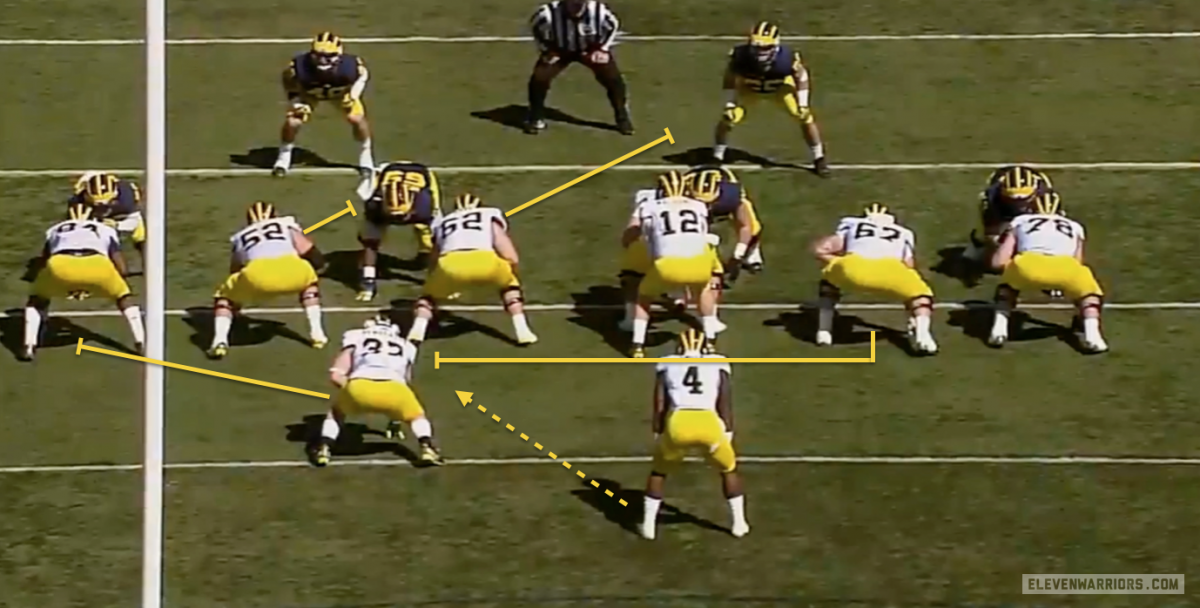
Both teams would consistently try to establish this concept from both single-back and I-formations, cementing its status as the base running play for the Wolverine offense. But Drevno wasn't done pulling guards and leading with his fullback.
Even without a speedy tailback on the roster, both teams called a number of toss sweeps, looking to get the ball on the outside with blockers in front.

The philosophy of gap-schemes calls for the play-side linemen to block down (a.k.a. inside), using the natural leverage given from their alignment to get in between their defenders and the ball. Meanwhile, the back is led through a designated hole by a lineman that pulled from the back-side (and/or a fullback), creating a numbers mismatch at the point of attack.
Zone schemes, meanwhile, call for all five linemen to block an area, using the same steps to get there. Obviously, there are many rules and techniques that must be taught to master the concept, but the philosophy is much simpler and easy to understand.
For this reason, more and more high school coaches have chosen to lean on those zone schemes, meaning the learning curve is much higher for incoming recruits that are asked to master these gap-based schemes.
That doesn't mean it's impossible, however, as having a good teacher makes all the difference. In just one year at the helm, Drevno installed one of the Pac-12's best rushing attacks, turning running back Javorius Allen into an all-conference performer and fourth-round draft pick in the process.
Though we may not have much film from the Maize & Blue game to work from, one can expect Harbaugh's offense to eventually look more like the one seen in Los Angeles than the one in the Bay area last fall. On nearly every Allen run, we can see at least one pulling linemen, creating holes for Power-O, Sweep, and Counter plays.
It remains to be seen, though, what the Wolverine aerial attack will look like once the full playbook has been installed. Harbaugh and Drevno have called on former Jaguars coordinator Jedd Fisch to lead their passing game, hoping the long-time NFL assistant can bring back the tradition of producing classic, drop-back quarterbacks in Ann Arbor.
But Fisch's track record has been notably checkered, calling plays for the consistently underwhelming Miami Hurricanes in 2011 and 2012. Surprisingly, that performance garnered his promotion back to the NFL, and less-than-sterling results followed during his two seasons in Jacksonville.
With little to build off of with the departure of quarterback Devin Gardner and leading receiver, Devin Funchess, Fisch and company have gone back to the basics. Quarterbacks Shane Morris, Alex Malzone, and Wilton Speight all threw a number of quick, three-step passing game concepts, looking to make a simple read before getting the ball out.
The slant-flat concept was by far the most common concept called in the spring game, looking to stretch the defense horizontally and showing Harbaugh hasn't forgotten his west-coast-offense roots. But the offense will look to attack on early downs through the air with play-action, throwing out of the same formations from which they'll also run to catch defenses off-guard.
One such example is the "snag" concept, which takes advantage of the short-motioned receiver seen in both the Power and toss examples above. Instead of looking for a crack block inside, the receiver settles down in space just outside the tackle while creating a triangle with the tight end's corner route and a flat route from the fullback.
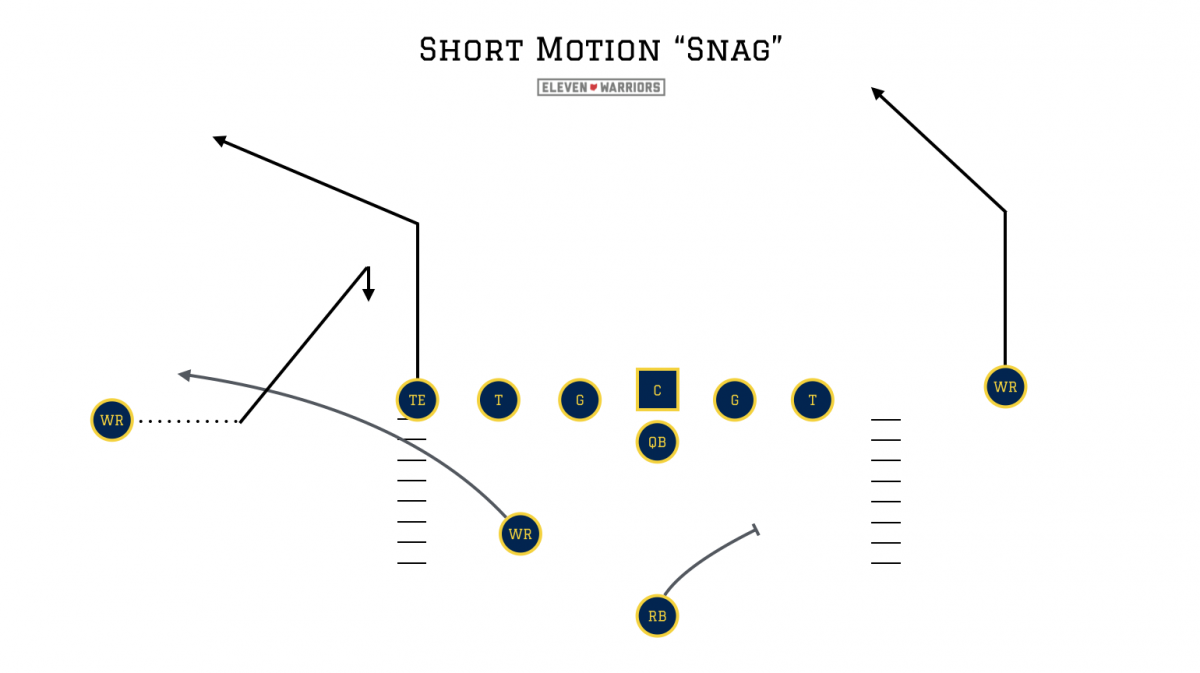
Fisch showed a number of concepts often associated with spread teams though, most notably through his frequent use of wide-receiver screens. These screens are a nice compliment to the run game, as they force the alley defenders to keep from cheating inside, and were even packaged with Power-O on a few occasions.
From there, Fisch and Harbaugh looked to build on more concepts from the same look, calling for multiple double-passes from these screens. While they were likely only called to liven up a spring game that had been dominated by the defense (it finished 7-0), the underlying philosophy came through: Harbaugh wants to suck in the defense before hitting them on a big play.

Yet questions still remain about the deep passing game, as limited practice time for three young QBs was likely focused more on fundamentals more than playbook installation. From what we've seen so far, it appears that Fisch has adopted a number of classic air-raid staples, such as mesh, Y-cross, and everyone's favorite, four verts.
Regardless of the concepts themselves, it's clear that Harbaugh and Fisch will expect their quarterback to stand tall in the pocket and have the ability to complete balls downfield into small windows, just as they would in the NFL.
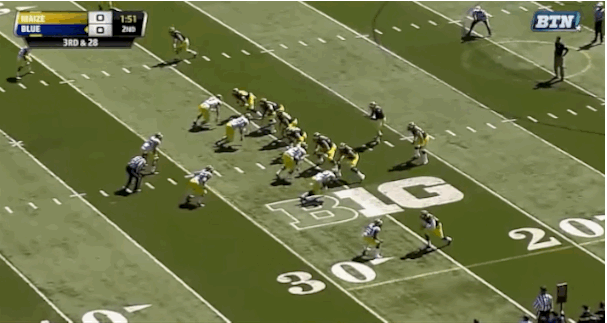
Even with a small sample size, overall we can tell that the Wolverine offense is going to take time to develop. Harbaugh, Drevno, and Fisch are all taking the long-view with their system, hoping to find big results over the long-term in return for growing pains early on.
But if Harbaugh wants an indicator of what happens if he doesn't get past that early hump, he doesn't have very far to look. The previous regime of Brady Hoke tried to install a very similar system, and never seemed to get the out of the learning phase.
Much of this system's success stems from the offensive line, and in that regard, the current regime has a major leg up in having a teacher like Drevno. The process won't be easy, and will likely be an ugly one this fall. With little pressure in Palo Alto, Harbaugh was able to go 9-15 in his first two seasons before finding success, so it seems a bit odd that he's putting so much focus on a team that may struggle early on.
If he's given the time though, he may just build a program strong enough to take back the leading role in the mitten state. As for the Big Ten as a whole? We'll see...
